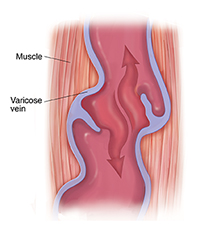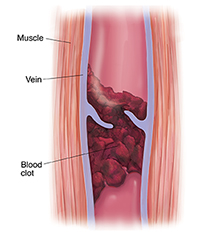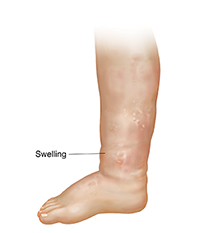A
B
C
D
E
F
G
H
I
J
K
L
M
N
O
P
Q
R
S
T
U
V
W
X
Y
Z
Topic IndexLibrary Index
Click a letter to see a list of conditions beginning with that letter.
Click 'Topic Index' to return to the index for the current topic.
Click 'Library Index' to return to the listing of all topics.
Understanding Leg Vein Problems
Leg veins carry blood from your feet and legs back to your heart. If a vein is damaged, it may cause problems in your legs.
The problems that may happen from damage to the veins include:
-
Varicose veins. This is a swollen, twisted vein located close to the skin.
-
Deep vein thrombosis (DVT). This is a blood clot in one of the deep veins, usually of the legs. The clot can separate from the vein and travel to the lungs (pulmonary embolism or PE). In the lungs, the clot can cut off the flow of blood. These two conditions together are called venous thromboembolism (VTE).
-
Chronic venous insufficiency. This is a long-term problem with the veins not working well.
Your healthcare provider can give you more information on these conditions and how to prevent and treat them.
 |
| Varicose vein. |
 |
| Deep vein thrombosis. |
 |
| Chronic venous insufficiency. |
When to call your healthcare provider
Call your healthcare provider right away if you have pain, swelling, or redness in one of your legs. These are the symptoms of a blood clot.
Call 911
Call 911 if you have:
These are the symptoms of a blood clot that has traveled to the lungs. This is a medical emergency and may cause death.
Online Medical Reviewer:
Anne Fetterman RN BSN
Online Medical Reviewer:
Deepak Sudheendra MD
Online Medical Reviewer:
Raymond Kent Turley BSN MSN RN
Date Last Reviewed:
12/1/2022
© 2000-2025 The StayWell Company, LLC. All rights reserved. This information is not intended as a substitute for professional medical care. Always follow your healthcare professional's instructions.